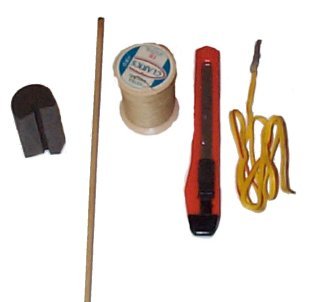Large Igniters
 |
Multiple types of motor igniters can be created. Only one type is presented here. This technique can be modified to accomodate other ignition materials and technologies. Additional techniques, such as dangling lengths of Thermalite down the core, can be employed to enhance motor ignition, which can be critical when igniting multiple stages.
Materials

- An electric igniter such as a Firestar, Fire in the Hole,
Magnelite or Daveyfire N28F. (The Daveyfire N28F can be enhanced
with a dip into a pyrogen like Firestar or Magnelite pyrogen.)
Two electric igniters can be used, if desired, to ensure that a return trip to the rocket to replace a defective electrical igniter is not needed.
- A grain of AeroTech Blue Thunder propellant.
You can get a grain
by buying a small Aerotech reload kit such as an F52 or H238.
Keep the propellant grain
and dispose of the other components in the kit.
- Carpet thread (strong thread)
- 1/8" dowel
- A knife
Directions
- Slice four slivers from the AeroTech Blue Thunder
propellant slug. The slivers shown here are about 2" long
and are from a 29mm slug.

- Position the propellant slivers around the igniter's pyrogen and wrap the thread around them to secure them to the igniter. Tie the thread.
Another group of slivers can be attached below the first group if desired. The fireball from the first group will ignite the second.

- Attach the igniter to a thin wood dowel (1/8").
This can be done by winding the
the igniter along the dowel and fastening with masking tape.
The dowel keeps the igniter from falling out of the motor.
Cut the dowel so that it sits on the ground or blast plate to hold the igniter
in the top of the motor.

- A test firing. (The fireball spreads out when not contained within the core of a motor.)

Submitted by Dean Roth
